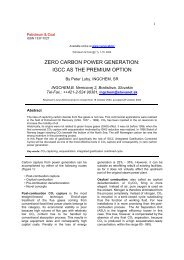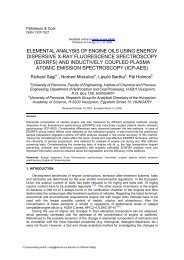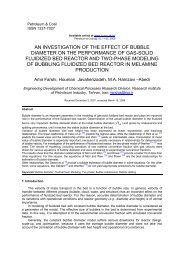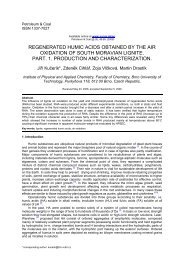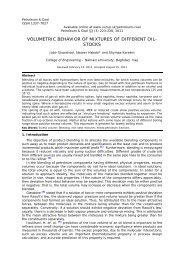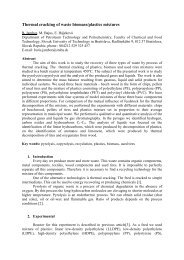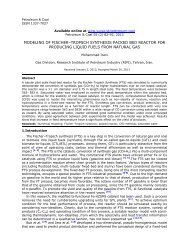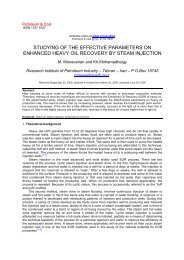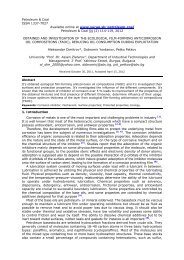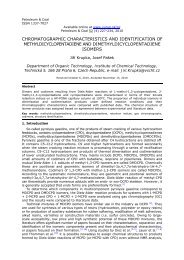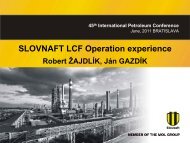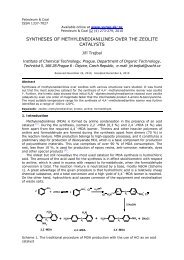diesel hydrotreaters revamp a way for increasing production
diesel hydrotreaters revamp a way for increasing production
diesel hydrotreaters revamp a way for increasing production
You also want an ePaper? Increase the reach of your titles
YUMPU automatically turns print PDFs into web optimized ePapers that Google loves.
44th International Petroleum Conference, Bratislava, Slovak Republic, September 21-22, 2009 2<br />
find a solution in this tough situation the technological department and the<br />
research laboratory made estimation about the required catalyst volume<br />
increase necessary to achieve <strong>production</strong> of NZSD in the hydrotreating units<br />
HDS-2 and HDS-3 running on a mixture of heavy straight run gas oil and light<br />
vacuum gas oil from Ural crude. This estimation showed that the liquid hourly<br />
space velocity (LHSV) should be approximately 1.0h -1 if the mixture of heavy<br />
straight run gas oil and light vacuum gas oil from Ural crude is hydrotreated at<br />
a pressure of 35 kg/cm 2 on the Topsoe TK-576 Brim catalyst. This catalyst<br />
proved to be among the best per<strong>for</strong>mers in the ultra low hydrodesulphurization<br />
[1,2]. The LHSV of about 1.0h -1 was possible to achieve if reactors with<br />
dimensions of the LNB FCC feed hydrotreating reactors were installed in the<br />
HDS-2 and HDS-3 units. Drawings of these reactors were available and this<br />
gave the opportunity to shorten the time <strong>for</strong> their manufacture. The LNB<br />
signed a contract with the Haldor Topsoe (HTAS) <strong>for</strong> basic engineering of<br />
reactor section <strong>for</strong> reconstruction of the LNB HDS-2 and HDS-3 units in<br />
November 2007. In late November 2007 HTAS assured LNB that the LNB<br />
FCC feed hydrotreating reactors fit the reconstruction of the HDS-2 and HDS-<br />
3 units and LNB signed a contract <strong>for</strong> manifacturing of the hydrotreating<br />
reactors <strong>for</strong> a period of less than 12 months with the Russian company OOO<br />
Energomash-Atomash. Having the bitter experience with appearance of<br />
leakage in the heat exchangers LNB was aware that the <strong>production</strong> of NZSD<br />
could fail if the older heat exchangers were used [3]. That is why a contract<br />
with the Ukrain company OOO Mashzavod was signed <strong>for</strong> manufacturing of<br />
shell and tube heat exchangers <strong>for</strong> utilization of the energy of the reactor<br />
product stream effluent. The delivery term <strong>for</strong> the heat exchangers was lower<br />
than 12 months. With this tight schedule the HDS-3 was reconstructed and<br />
successfully started up operation in late December 2008.The HDS-2 unit was<br />
reconstructed and successfully started up operation in early March 2009. The<br />
aim of this work is to discuss the achieved operation of the reconstructed LNB<br />
heavy middle distillate hydrotreating HDS-2 and HDS-3 units.<br />
EXPERIMENTAL<br />
The per<strong>for</strong>mance test of the reconstructed LNB HDS-3 was carried out in<br />
December 2008 at following conditions:<br />
- Feedstock properties<br />
Density at 15 °C, kg/m3 851.6-853.5<br />
Distillation, ASTM D 86, o C<br />
- IBP 208-220<br />
- 10% vol% 257-265<br />
- 50% vol% 294-300<br />
- 90% vol% 330-340<br />
- 95% vol% 338-349<br />
- EBP 355-360<br />
Sulfur , wt% 0.66-0.875<br />
Bromine number, g Br2/100 g 0.9-2.8<br />
Total aromatics,% 27.4-29.2<br />
Polynuclear aromatics , % 8.8-9.7



